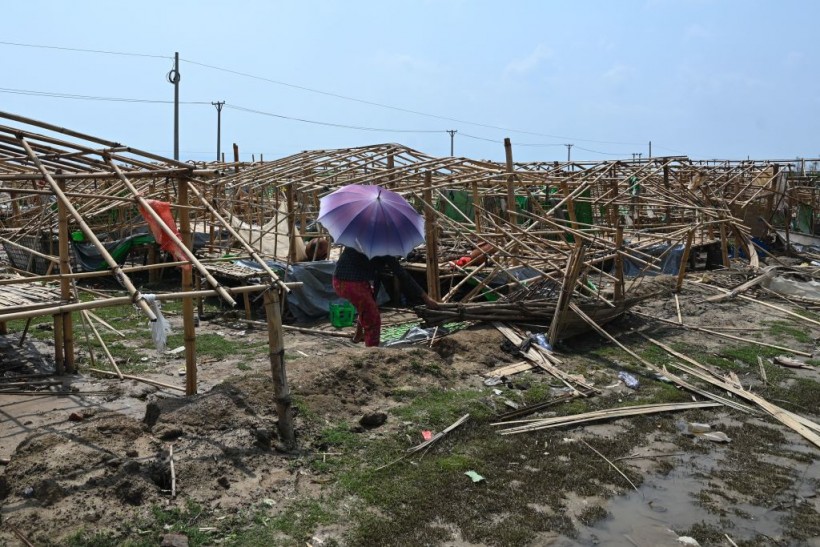Cyclone Mocha made landfall and struck the Myanmar and Bangladesh coasts, resulting in several dead people and widespread infrastructural damage, including power outages and disruption on communications due to downed power lines. Mocha brought powerful winds and heavy rain, resulting in flooding in fragile communities and especially those near coastal areas.
Last week, it was reported that almost 500,000 people in both countries were ordered to evacuate by local authorities prior to the cyclone's landfall, a story also covered by Nature World News. In Bangladesh, hundreds of cyclone shelters were established to accommodate affected residents by the looming storm at that time.
The United Nations and its agencies also provided emergency supplies such as food to the two countries before the weekend. The measures were given due to the expected devastating impact of Mocha, which traversed the Bay of Bengal last week before making landfall over the weekend. The cyclone is considered as one of the region's most powerful storms.
Cyclone Mocha Devastation

TOPSHOT - A woman carrying an umbrella attempts to clear debris in the Site Pyone Yay refugee camp near Ponnagyun Township in Sittwe district in Myanmar's Rakhine state on May 15, 2023, after cyclone Mocha made landfall. Cyclone Mocha made landfall on May 14 between Cox's Bazar in Bangladesh and Myanmar's Sittwe carrying winds of up to 195 kilometres (120 miles) per hour, the biggest storm to hit the Bay of Bengal in more than a decade.
At least six people were killed after Cyclone Mocha hit the coastlines of Myanmar and Bangladesh after it strengthened into a level equivalent of a category-five storm, the BBC reported on Sunday, May 14. The reported casualties were all from Myanmar, wherein 90% of the country's western Rakhine state's capital city of Sittwe was destroyed, residents told the U.K. broadcasting network.
In Bangladesh, no casualties have been reported yet but the country's disaster official Kamrul Hasan said flooding and landslides struck them.
On the other hand, the case for Myanmar is different since it received the main blow of the storm, as it pummeled through houses and power lines at a speed of 209 kilometers per hour (130 miles per hour), according to Myanmar's meteorological department, as cited by the network.
Cyclone Mocha Landfall
Cyclone Mocha slammed into the northwestern coast of Myanmar, over the waters off the Bay of Bengal, with the powerful wind gusts on Sunday, according to CNN, which said people can be seen rushing to temporary shelters.
The full magnitude of the storm's impact in the region is not yet known due to communication challenges. According to the United Nations Office for the Coordination of Humanitarian Affairs (OCHA), the "ongoing wild weather" in Rakhine and interrupted telecommunications means assessment of the full damage is not yet possible, as cited by the U.S. media outlet.
Un Resident Coordinator in Myanmar informed Al Jazeera from Myanmar's Yangon that the country's coast and Rakhine have dealt the most impact of the "extremely severe storm."
Bangladesh in South Asia, Myanmar in Southeast Asia, and their surrounding countries are prone to typhoons or cyclones at this time of the year and in the coming months.
In 2008, a powerful storm named Cyclone Nargis struck Myanmar from late April to early May of that year, killing over 100,000 people, making it Myanmar's world natural disaster in its recorded history.
Related Article: Cyclone Mocha: Hundreds of Thousands of People in Bangladesh, Myanmar to be Evacuated Due to Approaching Storm
© 2024 NatureWorldNews.com All rights reserved. Do not reproduce without permission.

![Climate Change is Reducing Dust Levels Worldwide as Arctic Temperature Warms [Study]](https://1471793142.rsc.cdn77.org/data/thumbs/full/70320/280/157/50/40/climate-change-is-reducing-dust-levels-worldwide-as-arctic-temperature-warms-study.jpg)

![Tsunami Hazard Zones: New US Map Shows Places at Risk of Flooding and Tsunamis Amid Rising Sea Levels [NOAA]](https://1471793142.rsc.cdn77.org/data/thumbs/full/70325/280/157/50/40/tsunami-hazard-zones-new-us-map-shows-places-at-risk-of-flooding-and-tsunamis-amid-rising-sea-levels-noaa.jpg)

